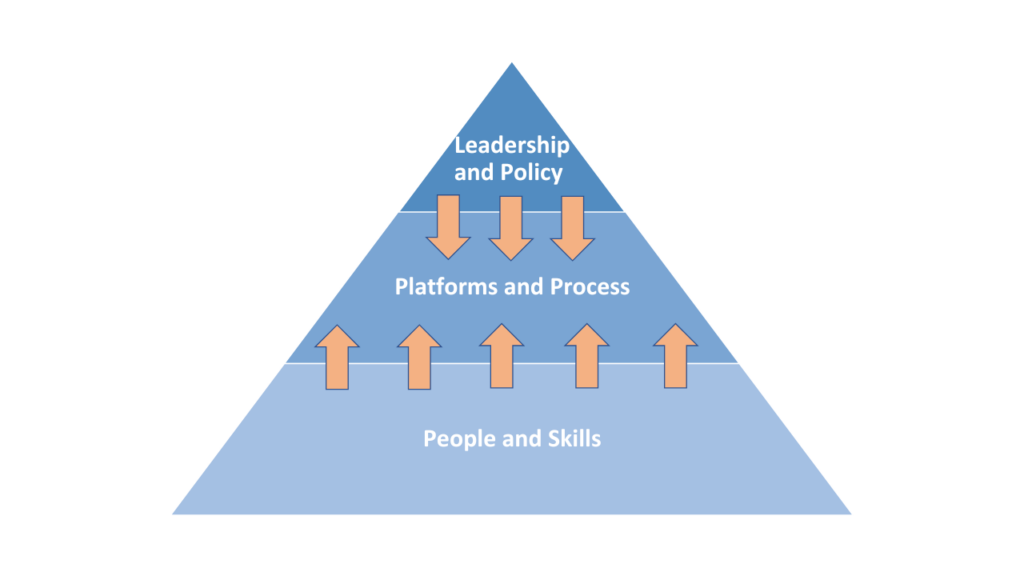The Digital Government Pyramid: Rethinking our Institutions for the Digital Era

April 19th, 2019
One of the hottest topics in public administration circles right now is “digital government.” A buzzword to be sure, but one that speaks to something real that is happening in governments around the world. There are many definitions for what ‘digital’ means, but the one that I like best was coined by Tom Loosemore (one of the founders of the UK’s Government Digital Service) in this tweet from 2016:

The digital government discussion is undoubtably driven by advancements in technology. However, in my view it is less about simply adopting those technologies to digitize what government already does, and more about using those technologies to re-engineer how government works at a deeper level. As Loosemore notes in his definition above, the driver for this change is the continuously rising expectations of citizens sparked by those same technological advancements. As former Canadian Minister of Digital Government Scott Brison was fond of saying, “We can’t be a Blockbuster government serving a Netflix citizenry.”
I increasingly think of the challenge we are trying to tackle when it comes to digital government as a three-layered pyramid. The top of the pyramid being the “leadership and policy” or the decision-making layer of government. The middle layer consists of the “platforms and processes” of government – the systems and structural elements of how government operates. And the base of the pyramid is what I call the “people and skills” layer, the raw materials, if you will, that drive the activities of government. Any digital government strategy needs to think about how to tackle all three of these layers in sequence.

Since the start of the digital government movement in the early part of this decade, most of the effort has been focused on the top of the pyramid. This has taken many forms, including work to change policies and regulations, the establishment of senior officials responsible for leading ‘digital’ across the organization, and the creation of dedicated digital government units such as GDS in the UK, 18F and USDS in the United States, or most recently, the Canadian Digital Service (CDS). This is a natural place to start in a hierarchical system, and likely also the right one as having the right leadership and ‘north stars’ or ‘exemplars’ to follow are critical for any large system change to take place. But in an organization as large and complex as government is, it simply isn’t enough.
In the last year there has been an increasing focus here in Canada on tackling the base of the pyramid. A collective recognition that systemic system change can’t happen in a sustainable way without raising the bar for everyone in that system. While we often think of government as a faceless organization, it is ultimately made up of people and therefore real change can only happen on a human level. This is something that we at the IOG have started working on through the creation of our Digital Executive Leadership Program, and is part of a broader network under the umbrella of the federal government’s Digital Academy initiative that is tackling the need to improve digital literacy skills at all levels of public sector organizations.
The final frontier for the digital government movement is perhaps the trickiest, namely the platforms and process layer in the middle. If you want to know where the action is going to be for the digital government movement in the coming years, my suggestion is to keep your eye on that space. It is only by tackling some of these complex and intertwined systems, practices, and structures that we can truly unlock the potential of the “Government as a Platform” vision. Areas that we might see more effort being put toward include solving the digital identity issue in a way that will work in the Canadian context, cleaning up legacy systems and shifting to modern cloud-based infrastructure and services, and modernizing often archaic human resources systems and processes.
Some of this admittedly often unsexy work has already begun in pockets at different levels of government, but it can’t be overstated how important it will be to the eventual evolution of our public sector institutions. Only by tackling all three layers of the pyramid will a truly digital government become reality. I’m encouraged by the efforts that are happening at various levels of the pyramid, and excited to work alongside many others across the country and internationally who are part of this movement. The goal is nothing less than reimagining our governance institutions for the digital era, and the foundations for that lofty vision are being laid today.